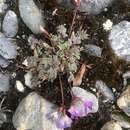Comprehensive Description
provided by North American Flora
Gynophoraria falcata Rydberg, sp. nov
A perennial, with a cespitose rootstock; stems decumbent, at least at the base, 1 dm. long or less; leaves 2-5 cm. long, spreading; stipules broadly deltoid, membranous, often slightly purple-tinged; leaflets 11-15, oval or elliptic, 3-4 mm. long, strigose beneath, glabrate above, rounded at each end; peduncles 4-6 cm. long; racemes 1-3-flowered, short; bracts lanceolate, 1-2 mm. long; pedicels 3 mm. long, hirsutulous; calyx minutely black-hairy, the tube campanulate, 3 mm. long, the teeth subulate, 2 mm. long; corolla apparently white or ochroleucous, fully 1 cm. long; banner broadly obovate, distinctly clawed; pod borne on a curved gynophore, 5-7 mm. long, the pod itself strongly arched upwards, acute at each end, papery, 1-celled, somewhat compressed, slightly inflated, 7—8 mm. wide, curved in a half-circle, 2-2.5 cm. in diameter, minutely hirsutulous with black hairs; seeds obliquely round-reniform, 3 mm. long.
Type collected between Lake Kluane and Don Jek River, Yukon, August 11-27, 1920, August Mutter (type in herb. Acad. Nat. Sci. Phila).
- bibliographic citation
- Per Axel Rydberg. 1919. (ROSALES); FABACEAE; PSORALEAE. North American flora. vol 24(1). New York Botanical Garden, New York, NY
Physical Description
provided by USDA PLANTS text
Perennial, Herbs, Stems woody below, or from woody crown or caudex, Plants with rhizomes or suckers, Taproot present, Nodules present, Stems very short, acaulescent or subacaulescent, Stems prostrate, trailing, or mat forming, Stems less than 1 m tall, Stems solid, Stems or young twigs sparsely to densely hairy, Leaves alternate, Leaves petiolate, Stipules conspicuous, Stipules membranous or chartaceous, Stipules persistent, Stipules clasping stem at the base, Stipules connate to each other, forming a tuber or sheath, Leaves compound, Leaves odd pinnate, Leaf or leaflet margins entire, Leaflets opposite, Leaflets 5-9, Leaflets 10-many, Leaves hairy on one or both surfaces, Flowers in axillary clusters or few-floweredracemes, 2-6 flowers, Inflorescences racemes, Inflorescence axillary, Bracts very small, absent or caducous, Flowers zygomorphic, Calyx 5-lobed, Calyx hairy, Petals separate, Corolla papilionaceous, Petals clawed, Petals ochroleucous, cream colored, Petals red, Petals blue, lavander to purple, or violet, Banner petal narrow or oblanceolate, Wing petals narrow, oblanceolate to oblong, Wing tips obtuse or rounded, Keel petals auriculate, spurred, or gibbous, Keel tips obtuse or rounded, not beaked, Stamens 9-10, Stamens diadelphous, 9 united, 1 free, Filaments glabrous, Style terete, Style persistent in fruit, Fruit a legume, Fruit stipitate, Fruit unilocular, Fruit tardily or weakly dehiscent, Fruit oblong or ellipsoidal, Fruit strongly curved, falcate, bent, or lunate, Fruit spirally coiled or contorted, Fruit or valves persistent on stem, Fruit exserted from calyx, Fruit inflated or turgid, Fruit beaked, Fruit glabrous or glabrate, Fruit hairy, Fruit 3-10 se eded, Fruit 11-many seeded, Seeds cordiform, mit-shaped, notched at one end, Seed surface smooth, Seeds olive, brown, or black.

